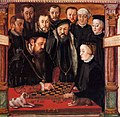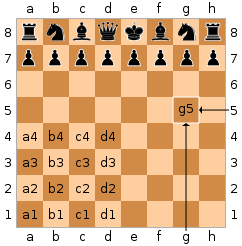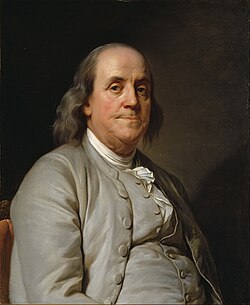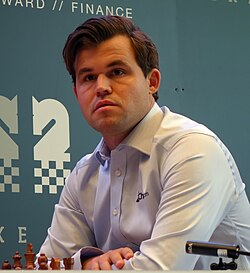Portal:Chess
Introduction
Chess is a board game for two players. It is an abstract strategy game that involves no hidden information and no elements of chance. It is played on a square board consisting of 64 squares arranged in an 8×8 grid. The players, referred to as "White" and "Black", each control sixteen pieces: one king, one queen, two rooks, two bishops, two knights, and eight pawns, with each type of piece having a different pattern of movement. An enemy piece may be captured (removed from the board) by moving one's own piece onto the square it occupies. The object of the game is to "checkmate" (threaten with inescapable capture) the enemy king. There are also several ways a game can end in a draw.
The recorded history of chess dates back to the emergence of chaturanga in 7th century India. Chaturanga is also thought to be an ancestor of similar games like Janggi, xiangqi and shogi. After its introduction to Persia, it spread to the Arab world and then to Europe. The modern rules of chess emerged in Europe at the end of the 15th century, becoming standardized and gaining universal acceptance by the end of the 19th century. Today, chess is one of the world's most popular games, with millions of players worldwide.
Organized chess arose in the 19th century. International chess competitions today are governed by FIDE (Fédération Internationale des Échecs), the International Chess Federation. The first universally recognized World Chess Champion, Wilhelm Steinitz, claimed his title in 1886; Gukesh Dommaraju is the current World Champion, having won the title in 2024. (Full article...)
Selected article -
Boris Vasilyevich Spassky (Russian: Борис Васильевич Спасский; January 30, 1937 – February 27, 2025) was a Soviet chess grandmaster who was the tenth World Chess Champion, holding the title from 1969 to 1972. Spassky played three world championship matches: he lost to Tigran Petrosian in 1966; defeated Petrosian in 1969 to become world champion; then lost to Bobby Fischer in a famous match in 1972.
Spassky won the Soviet Chess Championship twice outright (1961, 1973), and twice lost in playoffs (1956, 1963), after tying for first place during the event proper. He was a World Chess Championship candidate on seven occasions (1956, 1965, 1968, 1974, 1977, 1980, 1985). In addition to his Candidates wins in 1965 and 1968, Spassky reached the semi-final stage in 1974 and the final stage in 1977. (Full article...)
General images
Selected image
FIDE world ranking
| Rank | Player | Rating |
|---|---|---|
| 1 | 2839 | |
| 2 | 2813 | |
| 3 | 2795 | |
| 4 | 2773 | |
| 5 | 2769 | |
| 6 | 2769 | |
| 7 | 2768 | |
| 8 | 2764 | |
| 9 | 2763 | |
| 10 | 2762 | |
| 11 | 2753 | |
| 12 | 2750 | |
| 13 | 2743 | |
| 14 | 2742 | |
| 15 | 2740 | |
| 16 | 2740 | |
| 17 | 2738 | |
| 18 | 2738 | |
| 19 | 2732 | |
| 20 | 2729 |
Top 10 WikiProject Chess Popular articles of the month
Did you know...
- ... that there have been attempts to make chess an Olympic sport since at least 1924?
Reviewed articles
Chess from A to Z
| Index: | A B C D E F G H I J K L M N O P Q R S T U V W X Y Z (0–9) |
| Glossary: | A B C D E F G H I J K L M N O P Q R S T U V W X Y Z |
Topics
Subcategories
Related portals
Related WikiProjects
Associated Wikimedia
The following Wikimedia Foundation sister projects provide more on this subject:
-
Commons
Free media repository -
Wikibooks
Free textbooks and manuals -
Wikidata
Free knowledge base -
Wikinews
Free-content news -
Wikiquote
Collection of quotations -
Wikisource
Free-content library -
Wikiversity
Free learning tools -
Wiktionary
Dictionary and thesaurus










































































